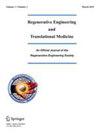藤茎银纳米颗粒的绿色合成、表征及应用
IF 1.9
Q3 ENGINEERING, BIOMEDICAL
Regenerative Engineering and Translational Medicine
Pub Date : 2023-03-07
DOI:10.1007/s40883-023-00298-x
引用次数: 3
摘要
绿色纳米技术作为一个领域已经出现,并受到生物学家的欢迎,因为它具有成本效益和环境友好的进步。最受欢迎的是涉及植物及其提取物的生物方法。采用全株藤茎粉末的光驱水提物(AE)法制备了银纳米颗粒。采用高分辨率扫描电子显微镜(HRSEM)、能量色散x射线(EDX)、高分辨率透射电子显微镜(HRTEM)和粒度分析等先进技术来确定纳米颗粒的性质。对其抗氧化、抗真菌和抗利什曼原虫活性进行了评价。该技术证实了所需尺寸范围的球形颗粒的形成。银纳米粒子对DPPH(2,2-二苯基-1-吡啶-水合肼)自由基的清除能力是AE的6 ~ 7倍。对多诺瓦利什曼原虫原鞭毛菌和无尾鞭毛菌进行了抗利什曼原虫和细胞毒活性评价。合成的AgNPs具有良好的抗氧化能力,具有明显的DPPH自由基清除能力。抗利什曼原虫活性在AE和AgNPs中均表现出极强的活性。这些结果支持了藤茎草高效合成AgNPs的趋势,该AgNPs可用于抗利什曼原虫的特性。本文章由计算机程序翻译,如有差异,请以英文原文为准。
Green Synthesis, Characterization, and Application of Ascophyllum Nodosum Silver Nanoparticles
Green nanotechnology as a field has emerged and gained popularity amongst biologists due to its cost-effective and environment-friendly advancements. The most preferred is the biological method which involves plants and their extracts. The silver nanoparticles were synthesized by a sunlight-driven aqueous extract (AE) of whole plant powder of Ascophyllum nodosum. Advanced techniques like high-resolution scanning electron microscopy (HRSEM), energy dispersive X-ray (EDX), high-resolution transmission electron microscopy (HRTEM), and particle size analysis were used to determine the nature of nanoparticles. Antioxidant, anti-fungal, and anti-leishmanial activities were evaluated. The techniques confirmed the formation of spherical particles of the desired range of size. Silver nanoparticles exhibited a much greater DPPH (2,2-diphenyl-1-picryl-hydrazine-hydrate) radical scavenging activity which was almost six to seven folds more than that exhibited by the AE alone. The anti-leishmanial and cytotoxic activities were evaluated on Leishmania donovani promastigote and amastigote. The synthesized AgNPs showed remarkable DPPH radical scavenging ability owing to their antioxidant properties. The anti-leishmanial activity was exceptionally viable in both AE and AgNPs. The findings all together support the tendency of Ascophyllum nodosum to efficiently synthesized AgNPs which could be utilized for its anti-leishmanial properties.
求助全文
通过发布文献求助,成功后即可免费获取论文全文。
去求助
来源期刊

Regenerative Engineering and Translational Medicine
ENGINEERING, BIOMEDICAL-
CiteScore
4.90
自引率
11.50%
发文量
41
期刊介绍:
Regenerative Engineering is an international journal covering convergence of the disciplines of tissue engineering, advanced materials science, stem cell research, the physical sciences, and areas of developmental biology. This convergence brings exciting opportunities to translate bench-top research into bedside methods, allowing the possibility of moving beyond maintaining or repairing tissues to regenerating them. The journal encourages both top-down engineering approaches and bottom-up strategies integrating materials science with stem cell research and developmental biology. Convergence papers on instructive biomaterials, stimuli-responsive biomaterials, micro- and nano-patterning for regenerative engineering, elastomeric biomaterials, hydrogels for tissue engineering, and rapid prototyping and bioprinting approaches are particularly welcome.
The journal provides a premier, single-blind peer-reviewed forum for the publication of original papers, authoritative reviews, rapid communications, news and views, and opinion papers addressing the most important issues and efforts toward successfully regenerating complex human tissues and organs. All research articles feature a lay abstract highlighting the relevance and future impact for patients, government and other health officials, and members of the general public. Bridging the gap between the lab and the clinic, the journal also serves as a dedicated platform for showcasing translational research that brings basic scientific research and discoveries into clinical methods and therapies, contributing to the improvement of human health care.
Topics covered in Regenerative Engineering and Translational Medicine include:
Advanced materials science for regenerative and biomedical applicationsStem cells for tissue regenerationDrug delivery for tissue regenerationNanomaterials and nanobiotechnology for tissue regenerationStudies combining tissue engineering/regeneration with developmental biologyConvergence research in pre-clinical and clinical phases
 求助内容:
求助内容: 应助结果提醒方式:
应助结果提醒方式:


